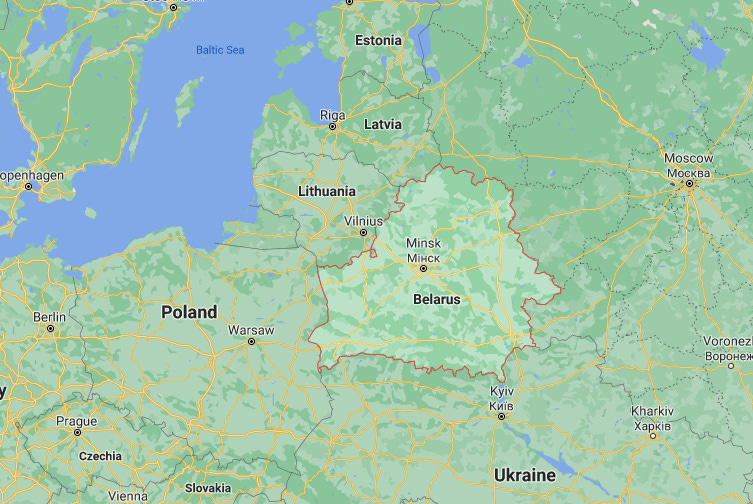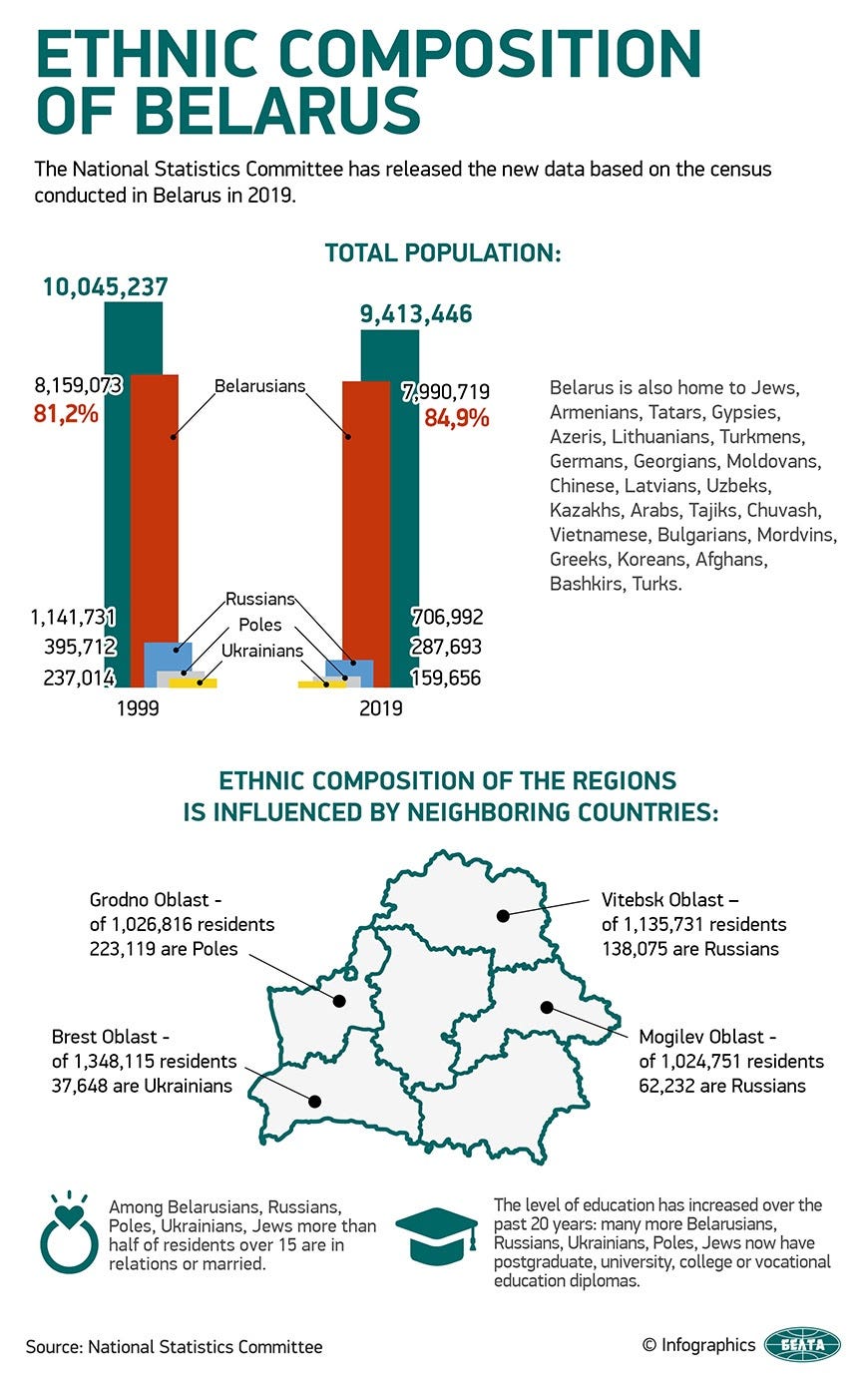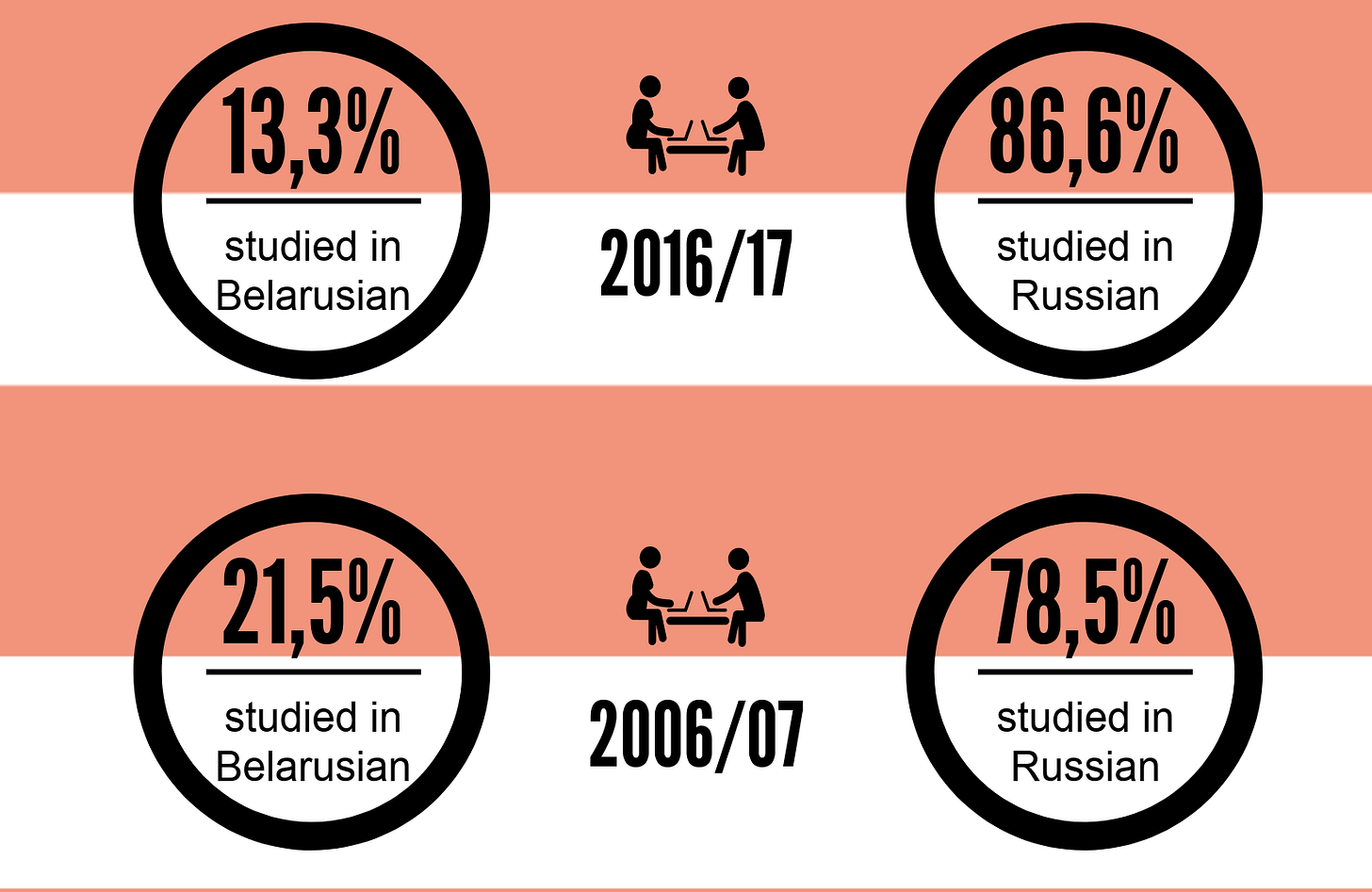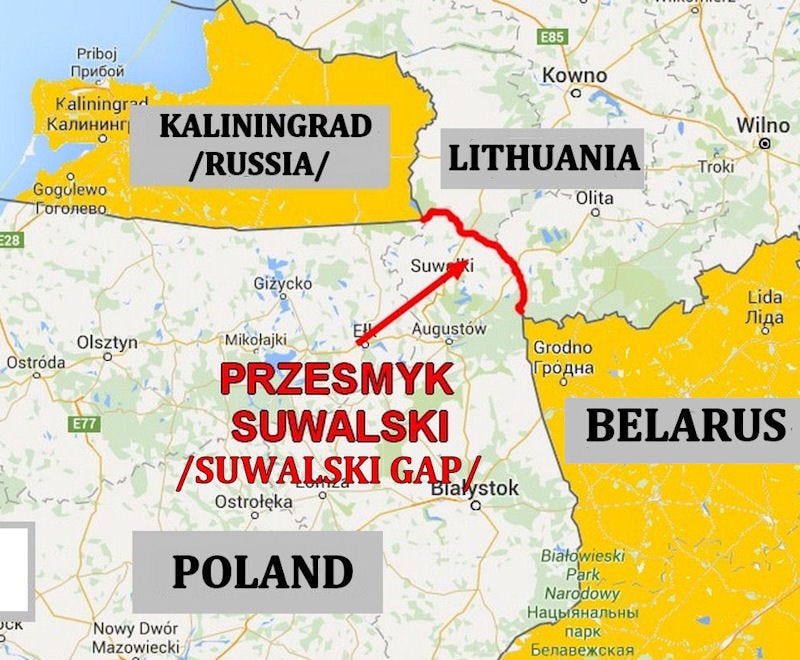🇧🇾 Belarus: Europe's Last Dictatorship

A Ryanair flight manipulated into landing in Minsk last weekend, and the arrest of an activist and his partner on board, brought Belarus firmly back in the headlines.
The act of "aviation piracy" shone a light on President Lukashenko's authoritarian regime, where for years there have been brutal crackdowns on protests against his power.
The incident raised questions for a lot of readers, who knew very little about Belarus.
You have likely read a lot about events this week, but the piece below will hopefully provide a helpful overview of the country to further those discussions.
Until tomorrow,
Hilary
*This post was originally published on May 30, 2021
INTRODUCTION TO BELARUS
Belarus is a country in north eastern Europe, bordering five countries - Russia, Ukraine, Poland, Lithuania and Latvia.
In terms of size, it is about 85% the size of the UK, but has a much smaller population of roughly 9.5 million people. About a fifth of the population are based in the capital, Minsk.

BRIEF HISTORY
Okay, let’s take it back a bit.
For much of the last century, what is today Belarus was one of the three Slavic republics in the Soviet Union, alongside Ukraine and Russia. At the time, it was called Byelorussia- which translates to White Russia.
By 1991, the Soviet Union collapsed and the new independent country became the Republic of Belarus.
That being said, the country still has very close ties to Russia. They signed a treaty in 1999 on a two-state union to ensure economic and political ties. It also relies heavily on importing energy from Russia - more about that below.
BELARUSIAN SOCIETY
- Ethnicity: While the vast majority of the population identify as Belarusian, a significant 706,000 identify as Russian. According to the country’s state-run news agency, it is home to at least 29 other “groups”.

- Language: The country has two official languages: Belarusian, and since 1995, Russian. The majority (70%) actually speak Russian in their day-to-day lives. According to the website Belarus in Focus, Belarusian education has become synonymous to many as “poor” and “minor” education, and is mostly found in rural areas.

- Relationship with alcohol: Belarus comes second in the top 25 countries based on alcohol consumption per capita. *Ireland is 15th on the list, the UK is 18th.
- Employment: Belarus reportedly has an unemployment rate of 0.2%, which would be the lowest in Europe. In 2015, a fine was introduced on anyone - excluding minors, the elderly and anyone with disabilities - who was unemployed for too long. What became known as the “social parasite” law, meant anyone who hadn’t paid income tax for at least 183 days of the year would be subject to a $245 fine.
- Views on homosexuality: Although it is not illegal to be gay in Belarus, social norms are not as welcoming. In fact, in 2012, Lukashenko stated that it was “better to be a dictator than gay.” There is no legislation protecting the rights of the LGBTQ+ community in general. Same-sex marriage is not legal, as the country’s constitution defines marriage to be between a man and a woman and the government has previously claimed that a “same-sex relationship is fake.” As well as this, gay couples can be refused the right to adopt and there is no ban on conversion therapy.
Views on abortion: What might surprise you is the fact that Belarus actually has one of Europe’s most liberal policies towards abortion. It’s legal for up to 12 weeks, and up to 28 weeks under special circumstances.
How high are the rates? Well, the most recent rates show 31.7 abortions per thousand women. To put that into context, the UK’s rate is 17 per one thousand, France is 16.9, Spain 8.3, and Germany 7.8.
Abortion rates are high and birth rates are low, causing a bit of a population crisis that Lukashenko has tried in vain - through offering benefits and passing legislation giving doctors the choice to not perform abortions - to reverse.
A previous study found contraception wasn’t widely used in Belarus either. While the study is at least a decade old, at the same time that 81% of sexually active people in Britain were using contraception, just 13% were in Belarus.
“We are taught that a gynaecologist is not a doctor who can give the gift of life, but someone who should help a woman at the time of an unplanned pregnancy. I don’t consider performing abortions for women who ask for it as helping women.” - Dr. Iryna Kazlouskaya, a gynecologist
JEWISH POPULATION
It is estimated that before World War Two, the Jewish population in Belarus made up around 40-50% of the population of some cities. During the Holocaust, roughly 800,000 Jews - 90% of the country’s Jewish population - were killed.
To this day, however, there are still strong Jewish communities in Belarus. Links to Israel are present, with three former Israeli presidents - Zalman Shazar, Chaim Weizmann, and Shimon Peres - all born in what is now known as Belarus. Also, the Israeli Education Ministry currently funds three Jewish day schools in Minsk, and three in other Belarusian cities.
Side note: Did you know that Ralph Lauren is the son of Jewish immigrants from Belarus? His name was Ralph Rueben Lifshitz, before changing it at the age of 16.
Jared Kushner - Donald Trump’s son-in-law and senior advisor, also has ties to Belarus. His family survived the Holocaust and fled from their homes in the Belarusian town Novogrudok- where their name and history is very well known- to escape the Nazis.
IMPACT OF CHERNOBYL
In 1986, an explosion at the Chernobyl nuclear plant exposed millions to highly dangerous levels of radiation.
While the explosion occurred in Ukraine, it was very close to the border with Belarus. In fact, two-thirds of the contamination from the explosion fell in Belarus.
Years after the explosion, UNICEF stated Belarus absorbed 70% of the fallout, with more than 20% of its adolescent children suffering from chronic illness or disabilities.
LUKASHENKO’S RISE TO POWER
According to the country’s state-run media, Lukashenko was born in northern Belarus in 1954, and was raised by a single mother. He graduated with degrees in both history and economics, enlisting in the army in between both.
Political rise: Lukashenko gained prominence in political circles in the early 1990’s, the same period as the collapse of the Soviet Union. In the year before becoming president, Lukashenko took charge of the parliament’s anti-corruption commission.
In 1994, he began his first term as President of the Republic of Belarus after gaining 80.3% of the vote. He has since won six terms in office without ever winning less than 75% of the vote - something Western leaders have repeatedly raised concerns about.
Within two years of becoming President, a referendum on constitution reforms consolidated his grip on power.
Side note: You may have seen some media outlets spelling his name as ‘Lukashenka’. Both are correct. ‘Lukashenka’ is based on the Belarusian transliteration, whereas ‘Lukashenko’ is based on Russian.
RELATIONSHIP WITH RUSSIA
Belarus has undeniably close ties to Russia. In terms of geography, Minsk is almost as close to Moscow as St Petersburg is.
Putin has long had the view that the collapse of the Soviet Union - under the leadership of Mikhail Gorbachev - was a disaster.
As CNN’s Fareed Zakaria once wrote, the collapse of the Soviet Union “left outside the Soviet sphere of influence millions and millions of Russian-speakers who think of themselves as Russian, who identified as Russian, in Ukraine, in Belarus, in the Baltics”.
What is worth noting is that while campaigning ahead of the election last August, Lukashenko did make reference to Russia being a threat. However, this was quickly off the agenda, as he looked east to Moscow for support amid mass protests against his leadership.
Last September, Russian Prime Minister Mikhail Mishustin spoke about Russians and Belarusians being “practically one people,” citing their religious, linguistic and historical connections.
Following the weeks of mass protests last summer - giving Lukashenko a sixth term in office - President Putin said Russian troops would be deployed “if the situation gets out of control”. Belarus also received a $1.5 billion loan from Russia during this time.
An EU Observer noted most of the country’s leaders in the army, the police and security services “have studied in Russian military or police schools”.
In terms of the economy, Russia is “by far” its main trading partner, with a BBC analyst saying it relies on Russia “very much, if not totally”.
Belarus does not have much natural resources, so it relies on imports from Russia “to meet most of its energy needs”.
“Belarus is also an important part of Russia’s gas transit corridor to Western Europe, and matters related to natural gas transit, such as infrastructure, system operations, tariff structure and technical services are established in a bilateral agreement with Russia’s Gazprom.” - A report from the International Energy Agency
In terms of Lukashenko and Putin’s personal relationship, it is often described in the media as being “strained at times”. However, the pair met in Sochi over the weekend, with Putin playing down the fallout over last weekend’s plane diversion and subsequent arrest of an activist.
Below are pictures of President Putin and President Lukashenko playing each other in a game of ice hockey in February 2020.

SUWALKI GAP
Another factor in the close ties between the countries lies in Belarus’ geographical location.
The Suwalki Gap is the 64-mile border between Poland and Lithuania. It is also the distance between Belarus and the Russian enclave of Kaliningrad.
North of Lithuania are Latvia and Estonia. All three of them - and Poland - are in NATO - the North Atlantic Treaty Organisation. If one NATO country is attacked, it is considered an attack on all. NATO’s relations with Russia - particularly after the annexation of Crimea - have consistently been strained.
In recent years, missiles have been deployed to Kaliningrad. Days before Donald Trump was elected in 2016, roughly 600 from Russia and Belarus’ military took part in a joint exercise near Belarus’ border with Poland.
In response, the US and NATO announced troops would be stationed in northeastern Poland.
If Russia was to ever seize this land, NATO would have no land access to defend Lithuania, Latvia and Estonia, making them very vulnerable.

RELATIONSHIP WITH THE US
Back in 2006, a number of Belarusian officials were sanctioned by the US over the presidential election, which western leaders considered “neither free nor fair”. President Lukashenko was personally banned from entering both the EU and the US at the time, in response to a brutal crackdown on protestors in the country.
In 2008, Belarus expelled the US Ambassador and 30 (out of 35) American diplomats. In 2015, Belarus agreed to release a number of political prisoners in order to have US sanctions lifted.
Interestingly, a Gallup poll found Belarus was one of just four countries - alongside Israel, Macedonia and Liberia - who had a more favourable view of the US once President Trump’s time in office began.
In the final weeks of Trump’s presidency, a US Ambassador to Belarus was appointed for the first time since 2008 - Dr Julie D. Fisher.
Responding to the Ryanair flight incident last weekend, President Biden’s administration announced that from June 3 “sanctions against nine state-owned companies” will be reimposed.
